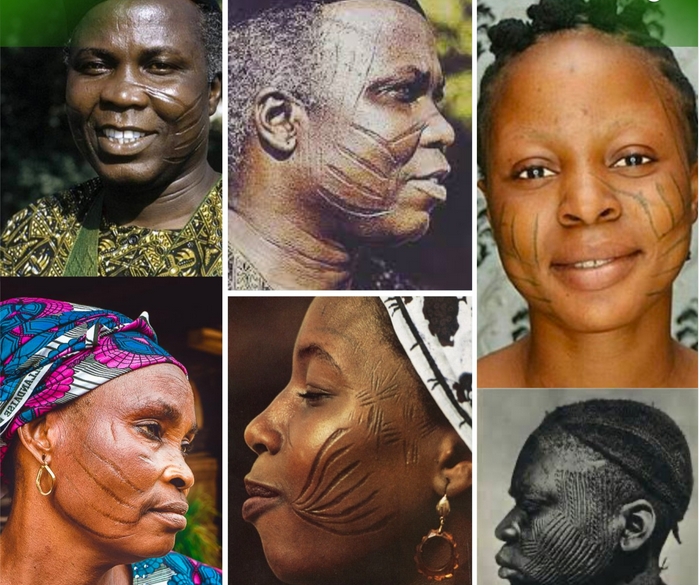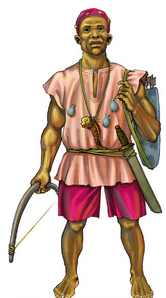
support@yorubalibrary.com
+2348073529208, 07038599574

Yoruba tribal marks are an ancient practice with deep cultural and historical significance. These marks, known as "ila," have been used for various purposes, including identification, beauty, and cultural expression. This article explores the history and meaning of Yoruba tribal marks.
History of Yoruba Tribal Marks
The tradition of Yoruba tribal marks dates back centuries and is deeply laced with the history and social structures of the Yoruba people. Historically, tribal marks served several key functions within the Yoruba communities.
• Identification and Lineage: Tribal marks were used to identify individuals and denote their lineage or family heritage. Different patterns and designs were associated with specific families, clans, or regions, making it easy to identify one's origins and ancestry.
• Social and Political Significance: In pre-colonial Yoruba society, tribal marks also played a role in social and political organization. They were used to differentiate between freeborn individuals and slaves, as well as to mark individuals who held certain social statuses or titles.
Types of Yoruba Tribal Marks
There are various types of Yoruba tribal marks, each with its unique pattern and meaning. These marks can be broadly categorized based on their design and the areas of the face or body where they are placed.
• Abaja: Abaja marks are horizontal or vertical lines, typically found on the cheeks. These lines can vary in number and length, often indicating specific family or regional affiliations.
• Pele: Pele marks are three vertical lines etched on each cheek. These marks are usually finer and less pronounced than Abaja marks and are often associated with beauty and aesthetics.
• Gombo: Gombo marks are more intricate, consisting of multiple patterns and lines that can cover larger areas of the face. These marks are often more elaborate and signify deeper cultural or family significance.
• Ture: Ture marks are curved lines or patterns that can be found on the forehead or other parts of the face. They are less common but hold specific meanings related to the individual's heritage or social status.
Cultural Significance of Yoruba Tribal Marks
Tribal marks in Yoruba culture carry profound cultural meanings and are often associated with rites of passage, beauty, and social identity.
• Rites of Passage: In many Yoruba communities, receiving tribal marks is a rite of passage. Children often receive these marks during ceremonies that signify their transition from infancy to childhood. These marks serve as a symbol of maturity and acceptance into the community.
• Beauty and Aesthetics: Tribal marks are also considered a form of beauty. In traditional Yoruba society, marked individuals are often seen as more attractive and distinguished. The patterns and designs enhance facial features and reflect cultural ideals of beauty.
• Social Identity and Pride: For many Yoruba people, tribal marks are a source of pride and a visible connection to their heritage. They signify belonging and identity, reinforcing social bonds and cultural continuity.
Modern Perspectives on Yoruba Tribal Marks
In contemporary Yoruba society, the practice of tribal marking has seen a decline due to various factors, including modernization, changing beauty standards, and concerns about health and safety.
• Changing Beauty Standards: As Western beauty standards influence Nigerian society, fewer people view tribal marks as desirable. Modern beauty ideals often favor unmarked skin, leading to a decline in the practice.
• Health and Safety Concerns: Concerns about hygiene and the risk of infections have also contributed to the decline of tribal marking. Traditional methods of creating these marks can pose health risks, leading many to abandon the practice.
• Cultural Preservation: Despite the decline, there is a growing movement to preserve the cultural significance of tribal marks. Some Yoruba people advocate for the documentation and celebration of these marks as an important aspect of their heritage.
Conclusion
Yoruba tribal marks are a significant aspect of Yoruba culture, reflecting a rich history and deep cultural meanings. While the practice has declined in modern times, its historical and cultural importance remains. Understanding the history and meaning of Yoruba tribal marks helps preserve this unique cultural heritage and highlights the intricate ways in which identity and tradition are expressed within the Yoruba community.

Learn about the Yoruba concept of Ìwà Pẹ̀lẹ́ (good…

Learn special praises for Divine Being and Creator…